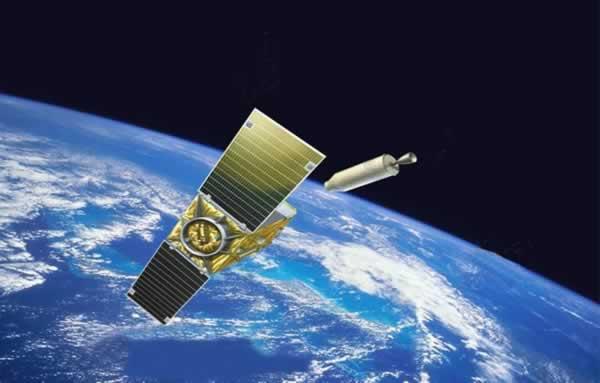| SPACE TODAY ONLINE COVERING SPACE FROM EARTH TO THE EDGE OF THE UNIVERSE | ||||||||||
| COVER | SOLAR SYSTEM | DEEP SPACE | SHUTTLES | STATIONS | ASTRONAUTS | SATELLITES | ROCKETS | HISTORY | GLOBAL LINKS | SEARCH |
Refuel, resupply, repair, reposition, remove:
XSS-11 Points To Fixing Satellites On Orbit
The Air Force's Experimental Satellite System-11, or XSS-11 for short, is a vision of the future, pointing toward a time when satellites flying on orbit will be refueled, resupplied, repaired, repositioned or removed from space.
Air Force Research Laboratory artist's view of XSS-11, left, approaching the upper stage of its Minotaur launch rocket, right, with Earth below.
XSS-11 was launched April 11, 2005, on a Minotaur I rocket from Vandenberg Air Force Base, California. Minotaur is a refurbished Minuteman missile.
In numerous tests since then, the 300-lb., dishwasher sized microsatellite successfully rendezvoused with the upper stage of its depleted launch rocket, which is nearby in space. XSS-11 approached as close as 1,500 feet from the discarded rocket.
It's a beginning. In the future, satellites like XSS-11 could approach aging, malfunctioning or inactive satellites, spent rockets and even chunks of space junk. During a rendezvous, a visiting satellite would burn its engines to approach and then move around the object while taking pictures and carrying out its mission plan.
Currently, large satellites routinely are abandoned as they malfunction or run out of fuel.
For XSS-11, ground controllers tell the small craft where to find a target. Then, a computer aboard the spacecraft controls its maneuvers around the target. XSS-11 autonomously calculates when to burn its engines. It has a laser range finder to measure the distance to a target.
A year in space. During its year or so of operation in space, the experimental satellite is intended to rendezvous with as many as eight objects in space. XSS-11 will approach only dead American research satellites and used rockets. Thousands of such space junk objects are in orbit over Earth.
XSS-11 photographs are made with a digital witness camera during so-called proximity operations.
Numerous small spacecraft with autonomous rendezvous capabilities are under development elsewhere by governments and corporations. British and Japanese microsatellites have flown in space.
There is a need for delivery, to orbiting satellites, of fuel and other consumable supplies as well as replacement modules and additional hardware.
Military uses. The XSS-11 project is managed by the U.S. Air Force Research Laboratory, Space Vehicles Directorate Integrated Space Experiments Division, Kirtland Air Force Base, Albuquerque, New Mexico, and operated by the Air Force Space and Missile Systems Center Detachment 12 at Kirtland AFB.
How could the military benefit from the satellite technology demonstrated by XSS-11? A satellite with the slow maneuverability of XSS-11 probably would not be used to attack other satellites. However, there are other non-weapon possibilities:
- A small maneuverable satellite could inspect larger U.S. satellites for accidental or hostile damage. Such a seek-and-diagnose satellite could be sent to space as needed, or one could be attached to a larger satellite at launch and then detach itself to scout around after arrival in orbit. That capability also might be of use during civilian space shuttle flights.
- A small maneuverable spacecraft could fly near a foreign satellite for a first-hand, close-up inspection or to intercept targeted beams of radio or laser communications.
Top of this page Satellites Search STO STO Cover Questions © 2006 Space Today Online
